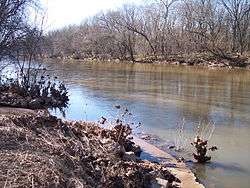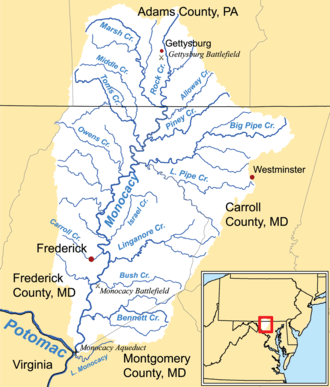Monocacy River
The Monocacy River (/məˈnɒkəsi/) is a free-flowing left tributary to the Potomac River, which empties into the Atlantic Ocean via the Chesapeake Bay. The river is 58.5 miles (94.1 km) long,[1] with a drainage area of about 744 square miles (1,930 km2). It is the largest Maryland tributary to the Potomac.
| Monocacy River | |
|---|---|
 The Monocacy River near Frederick in 2007 | |
 The Monocacy River watershed | |
| Native name | Monnockkesey |
| Location | |
| Country | United States |
| State | Maryland |
| City | Frederick |
| Physical characteristics | |
| Source | |
| • location | Harney, Carroll County, Maryland, United States |
| • coordinates | 39°43′11″N 77°13′03″W |
| • elevation | 400 ft (120 m) |
| Mouth | Potomac River |
• location | Dickerson, Maryland, United States |
• coordinates | 39°13′22″N 77°27′15″W |
• elevation | 200 ft (61 m) |
| Length | 58 mi (93 km) |
| Basin size | 744 sq mi (1,930 km2) |
| Discharge | |
| • location | Frederick |
| • average | 1,550 cu ft/s (44 m3/s) |
| • minimum | 573 cu ft/s (16.2 m3/s) |
| • maximum | 3,060 cu ft/s (87 m3/s) |
| Discharge | |
| • location | Bridgeport, Frederick County, Maryland |
| • average | 400 cu ft/s (11 m3/s) |
| Basin features | |
| Tributaries | |
| • left | Piney Creek, Double Pipe Creek, Israel Creek, Linganore Creek, Furnace Branch |
| • right | Toms Creek, Tuscarora Creek, Carroll Creek, Ballenger Creek |
The name "Monocacy" comes from the Shawnee name for the river Monnockkesey, which translates to "river with many bends." (However, another local tradition asserts that "Monocacy" means "well-fenced garden" in an Indian language.) The first town ever settled in Western Maryland, Monocacy, also gets its name from this river.
The Monocacy National Battlefield lies alongside part of the river, marking an 1864 engagement during the American Civil War, the Battle of Monocacy Junction. The Chesapeake and Ohio Canal crosses over the river at the Monocacy Aqueduct, the largest of the 11 aqueducts on the canal.
Geography
The river rises in Carroll County, Maryland, west of the unincorporated town of Harney at the Maryland-Pennsylvania border. The river is formed by the confluence of Marsh Creek and Rock Creek, which flow out of Adams County, Pennsylvania. Maryland tributaries include Furnace Branch, Tuscarora Creek, Carroll Creek, Linganore Creek and Ballenger Creek in Frederick County and Double Pipe Creek in Carroll County; other Pennsylvania tributaries include Alloway Creek and Toms Creek in Adams County.
About 60% of the Monocacy watershed is dedicated to agricultural use; about 33% of the watershed is forested. The city of Frederick and its suburbs form the largest urban area within the watershed.
The 960 square mile water shed averages a flow of 600 Mgd at the mouth where it enters the Potomac River.[2] Dendrology of the Watershed:
The vegetation of the watershed is very similar to what one would expect to find through the Piedmont and valley and ridge regions. Some invasive species that threaten the balance of the ecosystem. A very good source for plant and tree information is the USDA-NRCS Plant Fact Sheets.
Some Native or Established species that are viewed as beneficial vegetation in the watershed[3]
- White oak
- Red Maple
- Cattail
- Silver Maple(Second growth)
- Bald Cypress (Native, but may migrate due to climate change)
Some invasive species that threaten to disrupt the ecosystem of the watershed:
Pollution
The State of Maryland designated the Monocacy as a Maryland Scenic River in 1974.[4] However, it has one of the greatest nonpoint source pollution problems in the state due in large part to runoff from the 3,500 farms, livestock operations and dairies in the watershed. The Maryland Department of the Environment (MDE) has listed the Monocacy with impaired water quality for sediment and fecal coliform bacteria.[5][6][7][8] A major tributary basin, the Double Pipe Creek watershed, is also impaired for sediment and bacteria.[9][10]
Some farmers in the Monocacy watershed participate in the national Conservation Security Program operated by the U.S. Department of Agriculture (USDA), designed to help stem pollution due to erosion and pollutant runoff from farming.[11] In the 1990s the watershed was part of a national water quality demonstration project sponsored by USDA, which helped farmers reduce fertilizer usage and reduced discharges of nitrogen and phosphorus to the river.[12]
Point Source pollution within the watershed is fairly well identified and regulated with few options to further reduce inputs outside investment in better technologies to remove contamination from water to be discharged into the system. Because higher tech systems come at a higher cost it may be more effective for users to pay for removal of an equal or larger amount of nutrients from the system by installing natural storm water treatment features in urban and agricultural areas that will provide a better return on investment than trying the remove the last 5 mg/L of a nutrient out of wastewater discharge point. Generally nutrients from waste water can be reduced to around 10 ppm using low tech solutions, in order to achieve lower concentrations to meet TMDL’s higher technology systems must be used.[13]
Green solutions to addressing runoff pollution include using natural filtration systems like a buffer strip or bio filtration system to treat storm water and reduce the volume and velocity in which the storm water enters the drainage system.
The benefits of developing green infrastructure are many and reach beyond water treatment they include :
- Reduced runoff quantity
- Longer resonance time of water in the system
- Habitat Improvement
- Soil conservation
- Improved livability through green space
- Enhance property value
- Low impact and generally low cost
- Promotes native planting and growth
- Promotes stream restoration and health[13]
Because parts of the watershed near are underlain by karst topography it will be important to ensure that we are not loading groundwater in those areas to avoid destabilizing the subsurface resulting in a sinkhole, but that does not limit the use of bio retention and infiltration trenches, as long as they are lined in those areas.
Bio filters in a laboratory setting have been shown to remove up to 85% of phosphorus, 70% nitrogen and 95% of suspended solids from storm water prior to discharge for a properly sized unit. (Bratieres et al., 2008[14]) Although these results were observed in a controlled setting, a lower % removal would still make a significant impact in real world use given proper sizing and maintenance.
In urban areas the goal is to treat and address storm water where it falls and to mitigate storm surges in the water system that often increase the sediment, nutrient, and trash in the water course. This approach has an additional benefit of reducing scouring of the local stream beds to allow for stream bank stabilization. A side benefit is an increase in quality of life in hares with a high % of impervious surfaces, which often coincide with poorer areas in municipalities.
The state of Maryland has several good examples of storm water management systems in their design.[15]
For both urban and agriculture areas but especially for the agricultural regions of the watershed, we should promote the use of vegetative buffer strips to protect streams whether herbaceous ( grasses and/or brush) or forested. Regardless of the type of buffer there is general consensus among practitioners that a minimum 35” buffer on either side of a waterway is a preferred for an effective buffer strip to have the greatest effect but as seen in the North Carolina State report on buffer use and effectiveness, even a 15 ‘ buffer would have a significant impact to stream and watershed health. (NCSU, 2016) There will need to be a bit of negotiation in how much land a farmer or landowner is willing to give up which may or may not be the optimum thickness, but we should be sensitive to what the minimum thickness required to make a significant difference and what can be implemented. Buffer strip effectiveness
Buffer Type Width (M) % Sediment Reduction % Nitrogen Reduction % Phosphorus Reduction Grass 4.6 61 4 28 Grass 9.2 74 22 24 Forest 19 89 74 70 Grass/Forest 23.6 96 75 78 Grass/Forest 29.2 97 80 77 [16]
Thicker and forested buffer strips provide the best return on value for stream protection and nutrient removal. They have an added benefit of adding richness in the biodiversity of the watershed and protection for fields from wind and water action helping to keep soils and nutrients on the property. Tree’s add to the quality of streams by reducing the water temperature through shading, and providing structure to the stream in the form of downed trees and snags within the waterway that provide habitat for many species.
Grass and shrub buffers are still beneficial to the health of the watershed and conserving nutrients and soil on surrounding landscapes through soil and bank stabilization and reduction of water velocity entering the stream system from overland flow.[17][18]
The alliance is run out of the Frederick County Sustainability Office.
See also
- List of Maryland rivers
- List of rivers of Pennsylvania
References
- U.S. Geological Survey. National Hydrography Dataset high-resolution flowline data. The National Map Archived 2012-04-05 at WebCite, accessed August 15, 2011
- Frederick County, Monocacy Scenic River Board. "The Monocacy". Frederick County. Retrieved 30 October 2016.
- "Welcome to the PLANTS Database | USDA PLANTS". Plants.usda.gov. Retrieved 2017-03-16.
- Monocacy Scenic River Advisory Board. "Monocacy Scenic River Study and Management Plan." Archived 2006-09-15 at the Wayback Machine; Maryland Department of Natural Resources, Annapolis, MD. 1990. p.3.
- "Total Maximum Daily Load of Sediment in the Lower Monocacy River Watershed, Frederick, Carroll, and Montgomery Counties, Maryland" (PDF). Archived from the original (PDF) on 2009-07-31. Retrieved 2017-03-16.
- "Microsoft Word - Lower_Monocacy_ Bacteria_TMDL_07-20-07_PN.DOC" (PDF). Archived from the original (PDF) on 2009-07-31. Retrieved 2017-03-16.
- U.S. Natural Resources Conservation Service (NRCS). "Conservation Security Program - Monocacy Watershed." Archived 2009-03-20 at the Wayback Machine Accessed 2009-03-07.
- USDA. "Demonstration Projects – Selected Impacts" October 31, 2006.
- Bratieres, K., K; Fletcher, T; Deletic, A; Zinger, Y (August 2008). "Nutrient and Sediment removal by stormwater biofilters: Alarge-scale design optimization study". Water Research. 42 (14): 3930–3940. doi:10.1016/j.watres.2008.06.009. PMID 18710778.
- "Performance Criteria for Urban BMP Design" (PDF). Mde.state.md.us. Archived from the original (PDF) on 2015-09-06. Retrieved 2017-03-16.
- Jordan Simpson. "Riparian Buffers". Soil.ncsu.edu. Archived from the original on 2017-02-28. Retrieved 2017-03-16.
- "Soil Diagram". Soil.ncsu.edu. Archived from the original (JPG) on 2017-01-15. Retrieved 2017-03-16.
- "Monocacy and Catoctin Watershed Alliance | Frederick County MD - Official Website". Frederickcountymd.gov. 2016-12-06. Archived from the original on 2017-03-21. Retrieved 2017-03-16.
External links
- Monocacy Scenic River Water Trail Map & Guide - Chesapeake Bay Gateways Network (2006)
- Monocacy River factsheet - Alliance for the Chesapeake Bay
- Monocacy Watershed profile – US EPA
- Monocacy & Catoctin Watershed Alliance
- Monocacy Aqueduct – C&O Canal Virtual Tour
- Monocacy Basin Stream Monitoring Project
- Monocacy Battlefield – National Park Service
- Fishing the Monocacy River
- Kayaking/Canoeing the Monocacy
- Monocacy Scenic River Citizen's Advisory Board